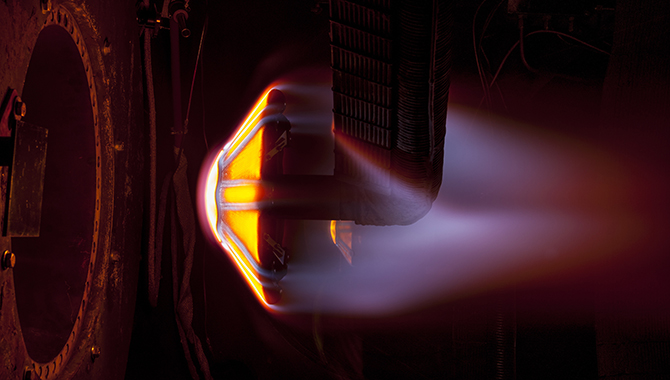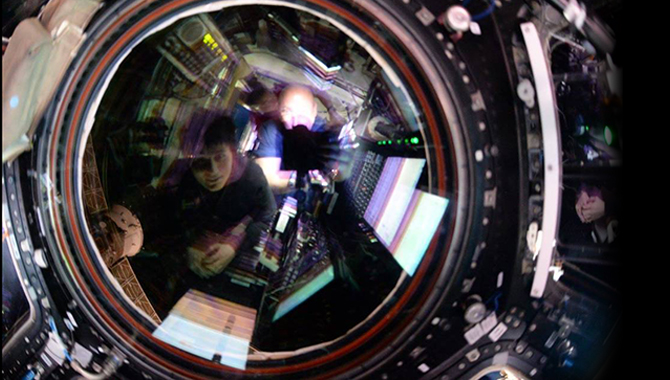
On August 13, 2015, an RS-25 engine underwent a hot-fire test to examine its ability to withstand the extreme temperature and pressure conditions that will occur during an actual SLS launch.
Photo Credit: NASA
NASA took a step farther along the journey to Mars with a successful hot-fire test of the RS-25 engine that will form part of the core stage of the Space Launch System (SLS).
When the agency next sends a crew into deep space, four RS-25s will power the SLS, the new heavy-lift launch vehicle that will take spacecraft beyond low Earth orbit (LEO). More powerful than any rocket in the world, the SLS is maximizing efficiencies by incorporating hardware from some of the agency’s most successful past programs. The RS-25s are a prime example: referred to as the Ferrari of rocket engines, they served as the space shuttle main engine (SSME) for 30 years.
“These engines are some of the most efficient and reliable engines in world. We have sixteen of them in our inventory and they have actually flown humans in space before, so we know they’re good engines,” said SLS program manager Todd May.
Modified to support the SLS, the RS-25s now produce 512,000 pounds of thrust compared with 491,000 for the shuttle. “That’s more than 12 million horsepower,” said SLS strategic communication team member Martin Burkey. “That’s enough to push 10 giant aircraft carriers around the ocean at nearly 25 mph.” The RS-25s will combine with two five-segment solid rocket boosters to send humans beyond LEO for the first time in over 40 years.
On August 13, the sixth of seven RS-25 hot-fire tests was conducted at Stennis Space Center. The test, which lasted 535 seconds—the same amount of time the engines will fire when the SLS launches—was performed to ensure that the upgraded RS-25 can withstand the extreme temperature and pressure conditions of an actual launch.
“You’re going to see this engine go from zero to five hundred thousand pounds of thrust in a little under five seconds and continue at that thrust level for the next eight and a half minutes,” said Aerojet Rocketdyne RS-25 program manager Walt Janowski.
Greater demands will be placed on the RS-25, which will operate at 109% power, for the SLS than for the shuttle. According to Burkey, the engine “has to handle temperatures as low as minus 400 degrees where the propellants enter the engine and as high as 6,000 degrees as the exhaust exits the combustion chamber where the propellants are burned. It has to move a lot of propellants to generate a lot of energy.”
“[W]e’re simulating the vehicle conditions pre-test and during the test,” said Gary Benton, chief of the project management branch of the engineering and test directorate at Stennis. “During today’s test we’ll burn about 150,000 gallons of liquid hydrogen and 60,000 gallons of liquid oxygen. That’s over 200,00 gallons total propellant. That’s enough to fill up ten of your average-sized swimming pools.”
Pressure and temperature reactions were not the only aspects explored during the test. “This engine has a new controller. The controller is the brain of the engine. We’ve got some updated software and we want to run this controller through all the paces and verify everything works just like it will for flight,” Benton said. The controller monitors the status of the engine and communicates between the RS-25 and the launch vehicle.
At 5:00 p.m. EDT, the engine ignited and ran for nearly nine minutes. Everything appeared to go as planned. “There are probably a few people in the control center high-fiving because that was a very, very successful test and you got to see an awesome display of the power,” said Benton.
Steve Wofford, manager of the SLS Liquid Engines Office, agreed. “The initial results are great. We ran full duration for 535 seconds and we met our test objectives.” The team will spend the next week or longer examining the data to make sure no anomalies occurred.
“One of our primary test objectives today was to demonstrate the four and a half minute chill cycle on the fuel side, which is a flight-like condition for SLS, and we hit that,” said Wofford, adding, “It’s a great day for NASA, it’s a great day for the SLS program, it’s a great day for our Liquid Engines Office and Aerojet Rocketdyne team. So it’s good to be here.”
The test took place in the center’s A-1 test stand, which was designated a national historic landmark in 1984. Paul Forman, public affairs team lead at Stennis, said, “The test stand that we’re using for the RS-25 test today was used during the Apollo Program for testing the upper stage of the Saturn V. That test stand was converted during the seventies, after the Apollo Program ended, for testing the space shuttle main engine for the shuttle program. Now we’ve converted it again for testing the RS-25 for the Space Launch System. So it’s had a rich history from the very beginning and is still being used today.” With this latest engine test, the A-1 stand is once more helping pave the way toward crewed missions into deep space.
View the successful 535-second RS-25 hot-fire test.
Watch a video about why the RS-25 is considered the Ferrari of rocket engines.
Read an APPEL News article about the use of heritage hardware on the SLS.
Read an APPEL News article about the successful Qualification Motor-1 (QM-1) test of an SLS solid rocket booster.









